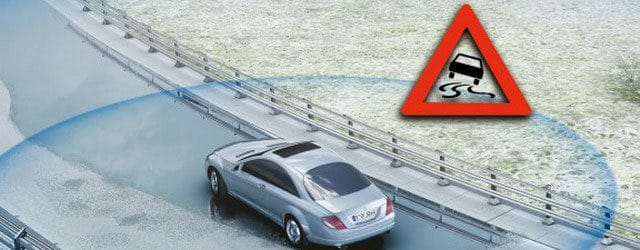Anti-lock brake system, commonly known as an ABS, is one of the most significant safety advancements of modern automobiles. The primary objective of the ABS is preventing vehicle from skidding when applied brakes in any road condition keeping the vehicle speed and wheel speed at a same level. It helps the driver to head the nose of the vehicle to a desired location even when full brakes are applied. This comes in handy when the road is slippery due to snow or rain fall. Some of the experienced drivers pedal the breaks in such a situations to prevent the vehicle from skidding, yet it’s highly risky to depend on human behavior since anything can happen within few seconds. Hence ABS has become a standard option in most of the automobiles in today’s market. Let’s take a deeper look in to ABS, how it works, the underlying technology and its evolution.

Energy Transformation in Braking
The common misunderstanding in braking is that the kinetic energy in the vehicle will be transformed in to thermal energy due to the friction in brake pads and the drum. It’s true that part of the kinetic energy will be transformed in to heat, but a large part of it will be transformed in to potential energy in front suspension. You definitely must have noticed that, the front suspension system gets compressed and vehicle leans forward whenever you apply breaks. That’s the actual transformation of Kinetic energy in braking process.
Kinetic Energy –> Potential Energy in Front suspension and thermal energy
The above power transformation will depend on the friction between the road and the wheel. If it was lesser than the friction between brake pads and the drum, wheels get locked and vehicle starts to skid. This is the reason why vehicles skid in slippery roads. Further in the case, front suspension gets totally pressed and when it has no capacity to store any more potential energy, the same thing will happen.
Why Do We Need ABS?
When you apply breaks on a road, part of the kinetic energy will be transformed in to thermal energy as usual and part will transform in to potential energy in suspension depending on road friction. If the road is slippery or in other words having less friction, vehicle has a lesser chance of transforming kinetic energy in to potential energy. Hence there will be a greater chance of vehicle getting skidded. If the vehicle stars to skid, there is no way to control the nose direction using the steering wheel.
As a solution some of the experienced drivers pedal the break is such situations. I have seen some drivers using the same technique to stop the vehicle in a shorter distance, without losing control in slippery roads. What exactly happen there is once the vehicle starts skidding they release the break pedal, so that the front suspension gets a chance to release its potential energy. After that the driver applies the break again so the suspension can store potential energy again.
ABS is an electronic braking system which can perform the above mentioned task more accurately and efficiently. The main objective is to maintain the vehicle speed and wheel speed at the same level. If wheel speed is ’0′ and vehicle speed is more than that, it means the vehicle is skidding. The simple technique used in ABS is, once the wheel speed reaches ’0′ it releases the break to measure whether there’s any vehicle speed left yet. If that be the case, wheels will start again, and front suspension will get released from its potential energy. Then ABS automatically applies break and will continue the same procedure till the vehicle speed and wheel speed both become 0.
Advantages of ABS
The main advantage is you will be able to stop the vehicle in a shorter distance since it utilizing the energy transformation to the maximum level. And it won’t let the vehicle to skid understanding the road conditions. Therefore you can apply full break in any road condition without any hesitation. As long as wheels are not getting locked, driver can head the nose of the vehicle to desired location while applying full brakes. This will reduces the driving stress significantly since we don’t have to concern about the amount of break we apply in any road condition.
Evolution of ABS
In the early stage of ABS it had very few signals to control its behavior. It calculates the wheel speed and captures the vehicle speed by releasing breaks while wheel speed is 0 through the same speedometer. And it treats all 4 wheels the same way. This system worked fine in general road conditions yet there were identified problems. In the case of vehicle is driving down a hill, the vehicle speed will never be 0 while it release the break to capture it due the energy transformation from potential energy to kinetic energy. Hence there was no way to totally stop a vehicle which is driving down the hill by using break paddles. The problem were quickly solved using a simple logic that if wheel speed were less that certain level it will be locked by break till the driver releases the break paddle.
Additionally, if all four wheels are not in same road conations, this kind of break system yet result a skid. If two wheels are on snow and others on clean road, once the driver applies break it will turn the vehicle in an uncontrollable manner no matter it has ABS. Having the objective of solving this problem modern ABS systems collect data separately from all four wheels and apply ABS accordingly.
In traditional ABS systems collect the vehicle speed data from the same speedometer while uses to collect wheel speed data which is not always an accurate a mechanism. It always requires releasing the breaks and letting the wheels to spin to capture the relevant data. Modern ABS system are been designed to capture the vehicle speed using GPS data which could be identified as a proper mechanism, yet it could be less accurate. However, it doesn’t require releasing the break to capture vehicle speed.
Advanced Application
Security has become one the major concerns in modern vehicles. In order to provide maximum safety, braking plays an immense role. The main objective is to leave no chance to human errors on the road. Therefore Anti-lock braking systems will continue to evolve. The modern ABS algorithm and computers collect wide set of data to control the behavior of the ABS functionalities. In the early stages it was just wheel speed and vehicle speed. Modern ABS systems are equipped with many sensors in brake pedal, all four wheels and the accelerator as well. They could be designed to capture weather conditions as an input signal to the algorithm to make it even accurate. The Electronic stability control which could be identified as an extension of ABS, applies breakings separately to each wheel using advanced algorithm which helps the driver to keep the vehicle on the track at greater speeds and on sharp corners. Recently ABS systems are plugged in to motorcycles and result was more than 40% lesser accidents. If your vehicle is also equipped with ABS and it’s well maintained, you don’t have to worry about skidding or controlling it when you apply breaks. All you have to do is just push the break paddle. ABS computer will do the hard part for you, and ensure maximums safety for your baby vehicle.
References
Tags: #ABS #Traffic
